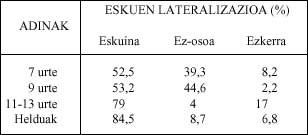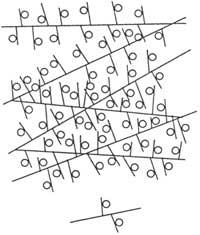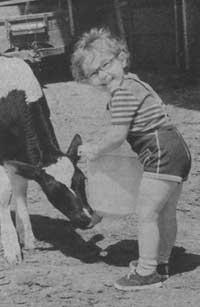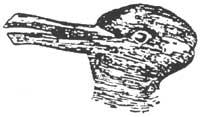Left-handed children
The theme of the left has always been a problem of general interest. The left-wing people, of course, have suffered or felt it especially because in some of them it has been a source of many problems (older or younger), especially when this trend has been repressed in childhood, when the child was forced to use the right hand, to write and in other activities of his childhood life (eat, use the knife, etc. ). ).
Historical and cultural information
The left have existed in all ages, and studies carried out in the stone instruments of the Neolite era show that in those times the number of left and right was quite equal.
Subsequently, the invention and use of weapons caused a division of labor between both hands. Therefore, one hand was used for the attack (right) and another for the defense of the chest cardiac environment (left).
The proportion of left is variable in the general population according to age. For example, in research at the University of Winipeg in Canada.

The most famous left can be Leonardo da Vinci. Everything he wrote did with the left hand, with the name of mirror writing. Other illustrious characters were left: Michel Angelo, Goethe, Nietzsche, Holbein, Beethoven, Schuman, ...
Throughout history, in the traditions of the peoples, there is already a social lateralization related to the sunrise and entrance.
- In Rome, and in Athens, the right was the most honoured and the main guest always stood to the right of the teacher.
- The same for the Jews. For them, while the right of Talmud (in his sacred book) expresses the haste, the left is the hand of justice and precision.
- Something similar for Christians: To the right of the Father of God Jesus Christ there is sedent and the good thief has always been crucified to the right of Jesus Christ.
- However, in China (although most people are also right), they traditionally honor the left as well as the right, and their main heroes are rightful and other right-wingers.
In the common language (at least in Spanish, French and English, in Basque it is not so obvious), the right indicates GOOD, CORRECT, ADEQUATE. The left, however, is synonymous with clumsy, of certain clumsiness, of little ability.
Laterality Laterality
It is a functional asymmetry that manifests in hands, feet, eyes, and other double organs. What is it expressed in? A certain difference predominates, even in directed activities.
Being left is not a bad habit, but something already biologically predetermined.
The laterality of a person appears in body and facial asymmetry. For example, right manual laterality is often accompanied by laterality of the feet and eyes, being at the base of all the left laterality of the brain.
The left hemisphere of the brain is imposed on most people, which makes these people right. On the left, on the contrary, the right hemisphere predominates. This domain of one hemisphere in the other is hereditary and is transmitted within the family. In his favor are the conclusions of the investigations carried out in the twins unibitelinos and bibitelinos. But, on the other hand, the fact of being left also appears as a personal and individual variable.

There is also a manual laterality acquired due to brain alterations during childbirth or encephalitis. In these people you can see other neurological signs and this type of left has been responsible and guilty of all the “bad fame” of the left.
In the growth of the fetus, the beginning of the largest volume of the cerebral left hemisphere has already been observed. Cerebral asymmetry is already observed in week 29 of pregnancy.
Manual laterality has different levels, so the left level is different: from the almost mere left (which barely serves them at all right) to the one used by the two hands of the other end.
The development of language is almost parallel to laterality.
The human being has until the seventh month two POSSIBLE language centers, and from now on the lateralization of the right (especially that of the hand) supposes a greater development of the left part of the brain, while the center of the right remains as “asleep” (if the circumstances demanded it, it largely recovers and would reinforce).
The functional domain of a hand is seen at the beginning of the 2nd year.
A delay in language acquisition may indicate that there has been a delay in the acquisition of laterality: this delay represents an increase in waist, starting from language.
Relations that may have the left and stuttering have always been the subject of debate, but today there is no consequence. Apparently, not only being left, but being the left of confirmation (or laterality not yet defined) would be the cause of the different language alterations (according to SOVÁK).
The obligatory primitive forms of education, which forced the own tendencies (in this case those of the use of the left), and the nervous impulses coming from both hemispheres to dance and to compete with each other, could produce alterations in the language, writing and manual skill. Today, by respecting this natural tendency of the child to use his right hand, the frequency of these errors and the sensations of inferiority and complexity that occurred at the same time has been reduced.
When does the problem appear? For the first acts of his life (games, meals, etc.) When the child begins to pick things up and is more important to write or draw when the child is forced to use one of the two hands (before in school he started at 5-7 years, but now quite earlier in the parvular).
Assessment of the child
- See relatives with the child's ruins (see if there is left or not)
- Perform an adequate neurological investigation of the child. Usually by extension (h.d.) diffusion) and balance (dg) there is an asymmetry of swings movement, between the upper body, head and feet. In people to the right there is hyperextensivity to the left and the movement of garbage to the left (especially in the feet) is increased. The same thing happens, but vice versa, on the left. Special movements are studied in the extremities (for example, in the upper extremities) or MOTOR CONTROL (the child is asked to touch the nasal tip with the index finger).
- Tests must be done in the parvulario. There are special test tests to measure the laterality of hands, feet, ears, and eyes. Normally, the hand rejection is accompanied by a visual disinterest.
Before diagnosis, the child must be left with complete freedom, on his own, observing and studying in detail. When its leftist condition has been diagnosed, it is necessary to promote, strengthen and reinforce this laterality, as has been indicated above, since the re-education that is carried out at the right hand will cause alterations in reading, language, writing and manual skill.
To write, we must teach him the most beneficial attitudes or positions for him.
His laterality, once consolidated, is convenient to train both right and left in his “bad” hand.
There are some children who tend to the right left (to ambidextrism), but it seems proven that it is not an ideal situation, let alone. It seems that with this education, problems can arise in language, writing and reading.
The left can act in almost all professions or trades, provided they have capacity for it. However, users of machines designed and adapted for the right should have special care and care.
Wegener found more left among students of the upper classes, but also among backward students, who could be treated as normally developed.
As for the tachygraphy, there is currently a special tachygraphy for the left, which is written from right to left (using the left hand).
Insecurity between left and right
1. constancy through the REY test.

In the image, all circles located to the right of short and quite vertical lines must be crossed.
Number of circles correctly labeled in the first session and then in the second. (1 minute per circle)
2. PIAGET test.
The one who performs the test is sitting in front of the child at the same table and asks:
- “Tell me, what is your right hand?”
- “Your left hand. Now be attentive!”...
- “My right hand, nerea, what is it?”
- And from my left?”
Now cross your hands on the table, as you do at school. Very good. I will put before you three objects (things): the inkwell, the keys, the clock (about 15 cm). Now you also have to answer my questions as soon as possible without moving your arms or hands.
- “Is the inkhorn on the right or on the left of the keys? Respond as before, from your side”
- “Is the inkhorn on the right or on the left of the clock?”
- “Are the keys on the right or on the left of the inkwell?”
If you respond “in the middle”, the child is forced to respond to the right or left.
- “Are the keys on the right or on the left of the clock?”
- “Well. Now, is the clock on the right or on the left of the keys?”
- “Is the clock on the right or on the left of the inkhorn?”
Evidence of tendency to displacement
* KRAEMER tests
- Let fall to the ground something that will turn or turn and see which hand is used to lift the child.
- The child must bring a book next to him.
- Classify the mixed letters. To see if you do it with both hands and what is the fastest or the most skillful.
- You must remove the lid from a quite strong box.
- Open the windows or doors and then reclose them.
- You will be asked to remove the slate.
- Write and underline your own name.
- Cut a square or a circle drawn.
- Turn on a poxpolo.
- Remove tip to a pencil.
- Take water in a tap and throw it to another container. Or water the flowers or fill a stream of water.
- Throw a ball.
- Give a tool box to the boys, especially to use the hammer. Give dolls to the girls. Put them, remove them, comb them.
- What is the most beautiful of the two images (left, right)?
- Place in the chain the beads or colored balls of a plastic thread with the model in front.
Once these tests are done, the tendency to displacement is measured:
0 = nothing 1 = very weak 2 = weak 3 = average level 4 = strong 5 = very strong (very strong)

It must be taken into account that there are new lefts that mean they are very skilled with the right hand, or pretend to do so (especially when they know the scope and meaning of their study). Therefore, we must use different tests. Paying attention to the child and asking the parents if getting used to using the right hand cost him a lot (long time or effort).
Visual tenacity
1 Checking out
- The child looks through a funnel that covers the two eyes. The funnel position indicates to the examiner what is the eye the child uses to see it.
- The child looks through the narrow funnel hole. Observe freely, freely, with what eyes you look at.
- Through a small hole (or a lock) the child is called to observe it. To see what eyes it uses.
If all these works are done with the same eye, no other study is necessary. If not, after a small distraction, it should be repeated along with other tests.
2 Duck/rabbit test PERRETA
This test is suitable for the smallest (and not very clear). Question from the examiner: “What animal is that?”, looking at about 60 cm.

Replies: Responses: Duck: right (right) Rabbit: left (left of eyes) The medium see two animals
3 Noise problems
It is worth mentioning the number of leftovers that have been found in patients with strabismus (but later they have become true again).
Strabismus, therefore, is an alarm for the pedagogue when there are errors in language, reading and spelling.
It should be sent to the oculista.
Pessimism of the feet
Below will be the most used tests. According to Kramer:
- Take the jump on a foot.
- Give a kick (as far as possible) to a ball or ball and stop later.
- Sing a song or lengthen it while taking the bar with the foot.
- Mark with the foot the rhythm of a melody or melody.
- Lift a few meters further pushing a box of poxpoles with the foot.
- Patinar.
- Walk forward with covered eyes (the strongest legs, or the main one extends the step further and at relatively large distances a curve is formed).
- Long jump (above a channel or a firewall).
- Jump in height (jump on a rope). To see which side you get the race at speed.
- Descend from a jump.
- Draw with the foot a circle or a square.
- Climb on a chair.
Laterality of the language
Emil Froschels, a research researcher in New York, discovers over 400 people: The 70% does so on the same side in which it predominates its manual laterality by clicking the language and more easily.
Auditory laterality

To see which is the main ear, on which side it predominates.
The SOVÁK test can be performed. On a table is placed a clock that works, along with other things and everything is covered with a cloth, in which the person has to look for the clock through the ear. The main ear is the one that approaches the fabric.
It is advisable to repeat this test.
The main ear, almost 50% of people, is in the opposite part of the main hand, according to data from Sovák.
Buletina
Bidali zure helbide elektronikoa eta jaso asteroko buletina zure sarrera-ontzian











